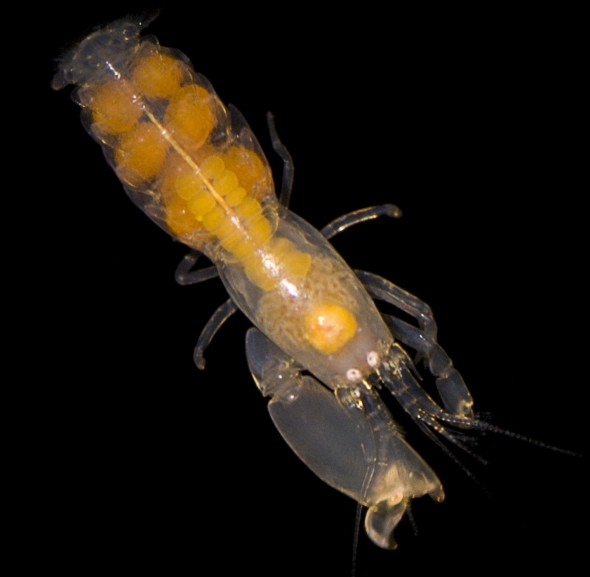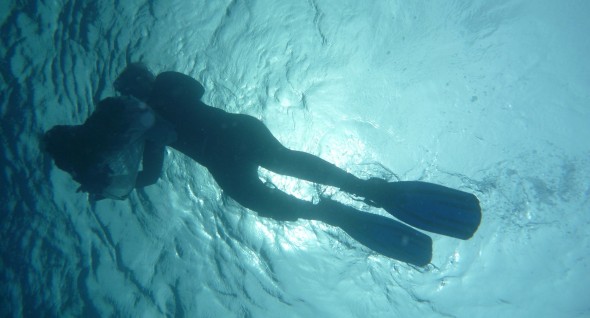
[Our team has just returned from a 10-day research trip to the Belize Barrier Reef, searching for social sponge-dwelling shrimp in a long-term study of these curious animals as models for understanding the evolution of altruism and cooperation. The New York Times “Scientist at Work” feature is posting updates from our field log. We reprint the first of several installments here, this one from my colleague Dustin Rubenstein of Columbia University — JED]
Monday, July 2
It has been two years since I wrote about stress physiology in African birds in the remote deserts of northern Kenya. Now, I find myself on a tiny island in the Caribbean studying shrimp. I’ve come here with J. Emmett Duffy from The College of William & Mary’s Virginia Institute of Marine Science. We will be joining forces to lead a team of five on a 10-day research expedition to Carrie Bow Cay, a tiny island six miles off the coast of Belize. We are trying solving a long-standing riddle, first articulated by Darwin himself, of why certain animals should give up their own individual careers and cooperate with one another in organized societies.
We study an obscure group of snapping or pistol shrimps, Synalpheus, which live in coral reef sponges. Not much bigger than a grain of rice, the 40 or so species in this group of marine crustaceans are intriguing. Like some of their more famous distant invertebrate relatives, like bees and termites, many species of Synalpheus are “eusocial,” living in complex societies with a single queen and dozens to hundreds of nonbreeding workers who guard the colony from intruders. But what’s unique about Synalpheus is that within this small group of crustaceans, we observe almost every other type of social system known in animals: in addition to eusociality, there are many Synalpheus species that live in sponges as a simple mated pair of male and female and virtually every gradation in between. From large colonies of multiple breeding pairs resembling colonies of seabirds, to small family units with several generations of offspring like cooperatively breeding birds or mammals, Synalpheus shrimp are among the most socially diverse groups of organisms on the planet. To figure out why we see such diversity and how it might have evolved, we have had to dive into their habitat on the Western Hemisphere’s largest barrier reef.
After arriving in Belize City, we take a short flight down the coast to the small town of Dangriga. It is sobering to see from the air the rapid expansion of citrus and shrimp farms along the coast; the mangrove swamps and tropical forests that had once lined the coastline have been cleared to grow produce and seafood for supermarkets in the United States. From Dangriga, we take a ride in an open boat to Carrie Bow Cay and arrive in the mid afternoon with enough time for a quick snorkel to get our bearings before dark. The island amounts to not much more than a main building and two sleeping quarters, both surrounded by coconut trees, and an outhouse on stilts over the water.
We set out the next morning to begin our sampling. Although we often use scuba to find shrimp at other sites, here we expect to get most of what we need snorkeling on the back reefs. We head out to an area called the sand bores, a series of reef pinnacles emerging from the depths of the lagoon that in some places even breach the surface at low tide. A mere 15-minute boat ride from Carrie Bow, the first reef we approach looks promising. Unfortunately, the thunder, lightning and soon pounding rain drive us back to shelter. Luckily, the squall passes quickly and we head back to the site for a second try once the coast is clear.

Synalpheus shrimp rarely leave the safety of their sponge hosts. They live inside their food sources, eating the lining of the sponge’s internal canals and probably also the microbes and detritus that accumulate there. It is not yet clear whether the shrimp are strictly parasitic or if the shrimp and sponges form a mutualistic relationship where they both benefit. What is certain, however, is that each species of shrimp is constrained to a specific one or few species of sponge. So looking for Synalpheus really means looking for sponges. Although the reefs are covered with a diverse sponge fauna, including colorful barrels, the shrimps primarily live inside the cryptic sponges found in the dead coral forming the floor of the reef. Therefore, to locate shrimps, we search for patches of dead coral or mounds of old coral rubble. The sponges often hold rubble together like glue, so we use a dive knife to gently pry pieces from the reef to bring to the surface.
We are more successful on our second try of the day, managing to get a number of bags of rubble before another storm chases us from the reef again. The ride back becomes a bit harrowing as the driving rain makes the visibility so poor we can’t even see the island. Eventually, we manage to make it home and begin the long process of picking shrimp, identifying the species under the microscope, and preserving the specimens for genetic, morphological, and histological analysis. We process shrimp long into the night, then collapse into bed, only to repeat the process the next day.
[Stay tuned for Belize 2012 field log 2 and beyond . . .]
Leave a Reply